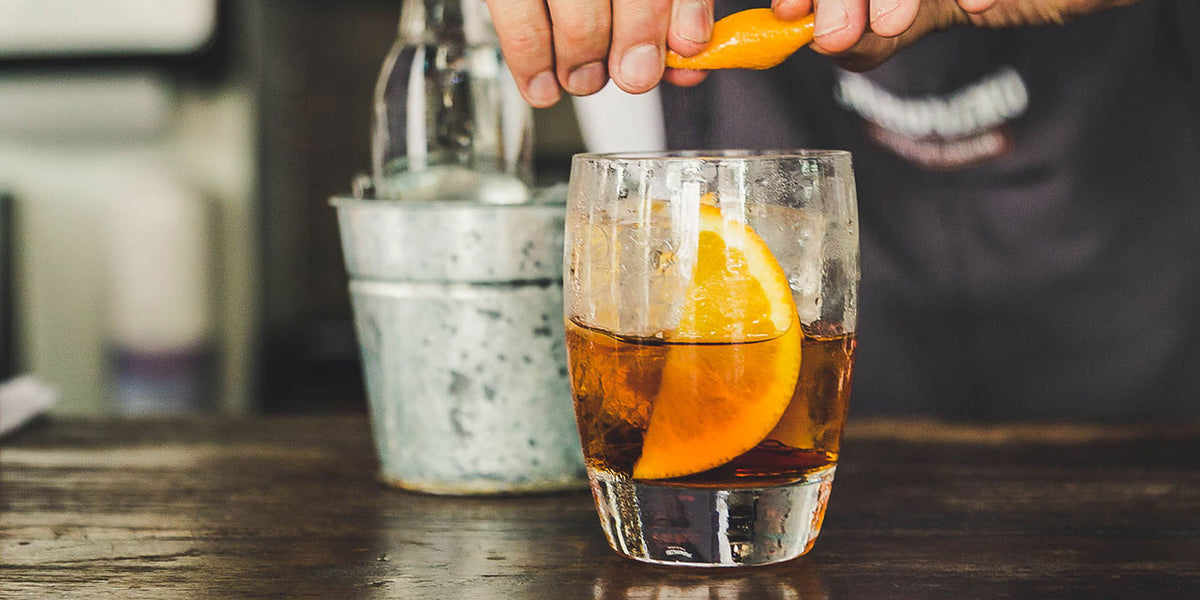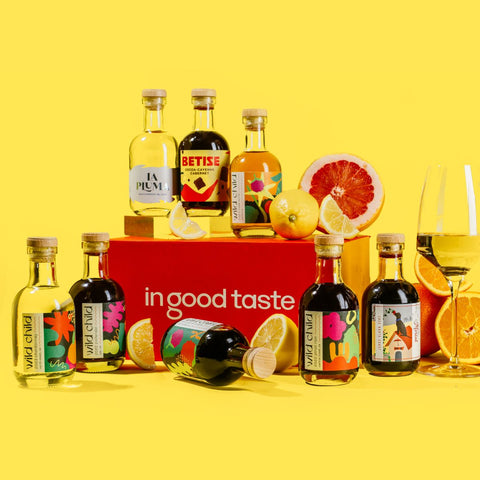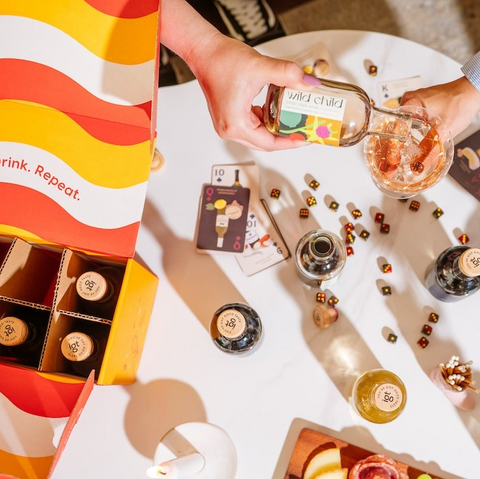What is Vermouth?
You’re out for a night on the town, and you decide that you’re in the mood for a cocktail that makes you feel sophisticated and fancy. You ask the bartender for a martini, or maybe a Manhattan, and you suddenly feel elevated to a new level of elegance. Those delicate, herbal notes in your high-class drink just make you feel so posh.
Huh, herbal… What's giving your cocktail that interesting taste anyway? That would be vermouth! Vermouth is not a liquor or a bitter like you might expect, but rather an aromatized (or infused), fortified wine that’s flavored with herbs and botanicals. Yep, that sophisticated cocktail of yours has wine in it, which in our opinion, makes it even better! Vermouth is having a bit of a renaissance in the US, so let’s take a closer look at this herbal drink and see what makes it so special.
History and Origin of Vermouth
Alcoholic drinks that have been infused with botanicals are nothing new, but drinking them purely for enjoyment is relatively new in the grand scheme of herbal drinks. Before the 16th century, botanical beverages that are similar to vermouth were used for medicinal purposes and were often infused with wormwood - an herb that has been used for centuries to treat indigestion and stomach problems.

The exact history of vermouth is slightly contested, and there are a couple of different versions of this story. Vermouth is the French pronunciation of the German word Wermut, which means wormwood. There is evidence that Germans used fortified wines with wormwood for medicinal purposes as early as the 16th century.
Around the same time, “wormwood wine”, a similar product infused with more botanicals, was made in Italy by an Italian merchant named D’Alessio. Soon after this introduction, several competing brands began popping up in eastern and southeastern France. It wasn’t until the mid-17th century that this beverage was referred to as “vermouth” by those who enjoyed it as an aperitif in England.
In another version of the vermouth story, Antonio Benedetto Carpano of Turin, Italy made the first sweet vermouth derived from ancient Roman recipes in 1786. Dry vermouth didn’t make an appearance until 1813 and was created by Joseph Noilly of France.
Although the exact beginnings of vermouth are unclear, we do know that in the late 19th century, bartenders began using vermouth in a variety of what we now consider classic cocktails, including the Manhattan, Negroni, and Brooklyn. Vermouth then saw a surge in interest in the 1950s thanks to the martini. You can thank Mr. 007, James Bond, for that! Its popularity waned in the late 20th century, but since 2013, it has seen a resurgence in the United States thanks to artisan makers who are taking a different approach than European vermouth producers.


Sweet Vermouth vs. Dry Vermouth
Generally, most vermouths can fall into one of two categories; sweet or dry. Sweet vermouth, or Italian vermouth, is red in color. It’s mildly bitter, slightly sweet, and has a fuller body than dry vermouth with a sugar content between 10 and 15%. On the contrary, dry vermouth, or French vermouth, is paler in color with more bitter notes, likely because of added nutmeg or bitter orange peel to the recipe. Dry vermouth is lighter in body than sweet vermouth and has a sugar content of no more than 4%.
In addition to the traditional sweet red and dry white vermouths, there are a few newer varieties on the market including a sweet white, golden, and rosé vermouth.
What Does Vermouth Taste Like?
There’s no one answer to describe what every vermouth tastes like, as each producer makes theirs differently from the next. Sweet vermouth is going to taste different than dry vermouth, and even within these categories, sweet and dry variations of vermouth will taste different from each other depending on the maker, the types of herbs and botanicals they use, how long they infuse their recipes with these botanicals, whether or not they age the wine prior to infusion, etc. You get the picture, there are a lot of variables that go into the flavor profile of vermouth.
There are, however, some commonalities that you’ll encounter in your vermouth tasting journey. Sweet vermouths are generally fuller-bodied, heavier, more flavorful, and, sweeter. They have notes of dark fruits, cocoa, caramel, and vanilla, and are best paired in cocktails with whiskey, bourbon, bitters, and sparkling wine. This is the vermouth that you’ll find in a recipe for a Negroni or a Manhattan.

On the other hand, dry vermouths are lighter, more floral, and much more bitter. They are quite herbal and a bit lean. They pair well in cocktails with gin, vodka, Campari, Aperol, Amaro, and Cynar. Dry vermouth is the one that you want on hand to channel your inner James Bond and make a mean martini with.

How Vermouth is Made
Producers of vermouth are highly secretive about their individual recipes, but we do have some idea about the general process that goes into making this delightfully herbal beverage.
The base of vermouth is a neutral grape wine or an unfermented wine. This provides a nice foundation to let the added flavors shine. The grapes that are used for this base are usually varietals such as Clairette blanche, Piquepoul, Bianchetta Trevigiana, Catarratto, or Trebbiano. Some producers may then choose to age the wine for a short while.

From here, the wines are fortified with fruit-based alcohol, usually, a brandy made with grapes or sugar beets, and are placed in large barrels or tanks where dry ingredients are already added. These dry ingredients can be any number of herbs and spices including cloves, cinnamon, citrus peel, cardamom, chamomile, coriander, juniper, lavender, hyssop, or ginger, just to name a few. Sweet vermouths also have sugar syrup added to increase the sugar content and body. The producers then let the wine become aromatized or infused with the herbs and spices over a period that lasts a few weeks. Finally, they remove the contents when the vermouth reaches a point that meets their standards.


Vermouth Recipes
Feeling inspired to rediscover the delicious qualities of vermouth? While it tastes wonderful on its own, it’s also a welcome addition to several classic cocktails. To kickstart your inspiration, take a look at a few of our favorite cocktail recipes that feature vermouth as an ingredient:

Americano
Ingredients:
-
1 ½ ounce of Campari
-
1 ½ ounce of Sweet Vermouth
-
Soda water
-
Orange peel twist
Directions:
-
Fill a glass with ice, then add the Campari and Vermouth.
-
Fill to the top with soda water, then garnish with the orange twist.

Negroni
Ingredients:
-
1 ounce of gin
-
1 ounce of Campari
-
1 ounce of Sweet Vermouth
-
Orange peel twist
Directions:
-
Add the gin, Campari, and sweet vermouth to a glass filled with ice and stir until it’s sufficiently chilled.
-
Garnish with the orange twist.

Martini
Ingredients:
-
2 ½ ounces of gin
-
½ ounce of Dry Vermouth
-
1 dash of orange bitters
-
Lemon peel twist
Directions:
-
Add the gin, dry vermouth, and orange bitters into a mixing glass and stir until it is cold.
-
Strain the mixture into a chilled martini glass, and garnish with the lemon twist.

Vermouth Spritzer
Ingredients:
-
3 ounces of Prosecco
-
2 ounces of Dry Vermouth
-
1 lemon slice
-
1 sprig of mint
Directions:
-
In a glass filled with ice, mix the Prosecco and dry vermouth and stir until chilled.
-
Add the lemon slice and mint to garnish.
Vermouth Substitutes
If you don’t have any vermouth on hand to make these cocktails, there are a couple of alternatives that you can consider. For dry vermouth, consider using Cocchi Americano or Lillet Blanc. For sweet vermouth, another option is Dubonnet Rouge. These substitutions won’t give quite the same flavor, but they will work for your cocktail recipes when you’re fresh out of vermouth.
Ready to step out of your comfort zone and test the waters of vermouth? Whether you decide to enjoy it as part of a classic mixed beverage or on its own as an aperitif, get ready to experience something herbal, classy, and truly unique.












